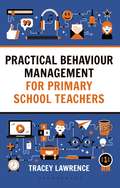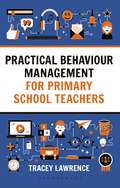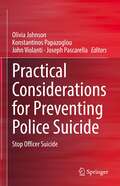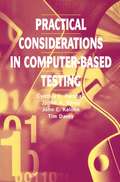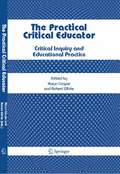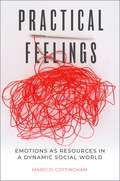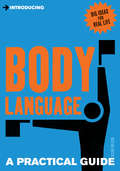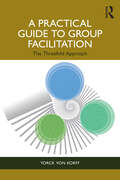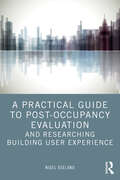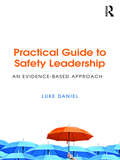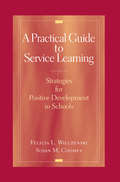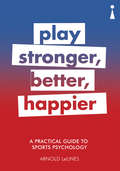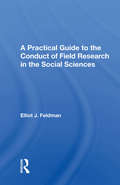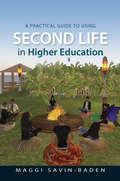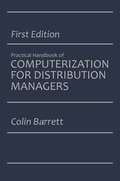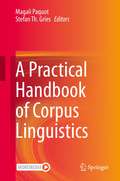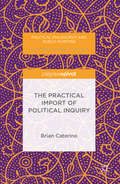- Table View
- List View
Practical Behaviour Management for Primary School Teachers
by Tracey LawrencePractical Behaviour Management for Primary School Teachers will provide you with practical strategies at every part of your teaching journey, enabling you to create an inclusive environment in your own classroom. By giving you step-by-step guidance on different strategies that you can implement, Tracey Lawrence supports you on the journey to unlock the potential of every child – because every child deserves a high quality education. The book will top up your teaching toolkit by covering a range of topics around managing behaviour, from low-level issues to more extreme cases, as well as well-being and mental health concerns. It provides case studies, discusses the responsibilities of the teacher, how to set meaningful targets, plus lots of tips on how to get the best out of available support and intervention strategies. Not only that, you also get real classroom anecdotes and exercises to use in lessons right away so you feel fully prepared to support all children with confidence.
Practical Behaviour Management for Primary School Teachers
by Tracey LawrencePractical Behaviour Management for Primary School Teachers will provide you with practical strategies at every part of your teaching journey, enabling you to create an inclusive environment in your own classroom. By giving you step-by-step guidance on different strategies that you can implement, Tracey Lawrence supports you on the journey to unlock the potential of every child – because every child deserves a high quality education. The book will top up your teaching toolkit by covering a range of topics around managing behaviour, from low-level issues to more extreme cases, as well as well-being and mental health concerns. It provides case studies, discusses the responsibilities of the teacher, how to set meaningful targets, plus lots of tips on how to get the best out of available support and intervention strategies. Not only that, you also get real classroom anecdotes and exercises to use in lessons right away so you feel fully prepared to support all children with confidence.
Practical Considerations for Preventing Police Suicide: Stop Officer Suicide
by Olivia Johnson Konstantinos Papazoglou John Violanti Joseph PascarellaThis book takes an in-depth look at the phenomenon of police officer suicide. Centered on statistical information collected from cases of officer suicide from 2017 to 2019, this volume helps readers understand the circumstances surrounding death by suicide amongst law enforcement personnel and makes recommendations for identification and prevention. Through interview and case presentations, this volume examines the lives and last days and weeks of several officers, using findings from social media, departmental surveys, medical examiner reports, toxicology reports and interviews with loved ones and colleagues to create a psychological autopsy. With 14 chapters contributed by former law enforcement, researchers, and mental health professionals, it addresses national, state, and local policy implications and strategies, presenting a theory for better understanding and preventing the phenomenon of officer suicide. This volume will be of interest to researchers in policing, to law enforcement and first responder leadership and administrative professionals, and to mental health practitioners and clinicians working with this unique population
Practical Considerations in Computer-Based Testing (Statistics for Social and Behavioral Sciences)
by Cynthia G. Parshall Judith A. Spray John Kalohn Tim DaveyThis book introduces computer-based testing, addressing both nontechnical and technical considerations. The material is oriented toward practitioners and graduate students. The practical emphasis will be useful to measurement professionals who are or will be responsible for implementing a computerized testing program. The instructional information is also designed to be suitable for a one-semester graduate course in computerized testing in an educational measurement or quantitative methods program. While certain theoretical concepts are addressed, the focus of the book is on the applied nature of computerized testing. For this reason, the materials include such features as example applications, figures, and plots to illustrate critical points in the discussions. A wide range ofnontechnical issues need to be considered in implementing a computer-based testing program. Separate chapters are provided on test administration and development issues, examinee issues, software issues, and innovative item types. Test administration and delivery issues include the location of exam administration, selection of hardware and software, security considerations, scheduling of administration frequency and time limits, cost implications, and program support as well as approaches for addressing reliability, validity, comparability, and data analysis. Examinee issues include the influence ofexaminees' reactions to adaptive testing, the effect ofcomputer based task constraints, and the impact of examinees' prior computer experience. Software issues include usability studies and software evaluation as tools in selecting and developing appropriate software, based on the test program needs.
The Practical Critical Educator: Critical Inquiry and Educational Practice
by Karyn Cooper Robert E. WhitePremised on the need for democratic education and positive social change, this book is about being sensitive to, respecting, and honoring differences. It connects the professional lives of educators with critical democratic practices. Using concrete examples, the editors promote the assertion that every educator can become an agent of change. Moreover, the book presents the experiences of professionals involved in effecting positive change.
Practical Feelings: Emotions as Resources in a Dynamic Social World
by Marci D. CottinghamTracing emotions across work, leisure, social media, and politics, Practical Feelings counters old myths and shows how emotions are practical resources for tackling individual and collective challenges. We do not usually think of our emotions as practical, yet they often interlace the elements of daily life. In Practical Feelings, Marci D. Cottingham develops a theory of emotion as practical resources. By integrating the sociology of emotion with practice theory, Cottingham covers diverse areas of social life to show the range of an emotion practice approach and trace how emotions are put to use in divergent domains. Spanning work, leisure, digital interactions, and the political sphere, Cottingham portrays nurses, sports fans, social media users, and political actors in more complex, holistic ways. Practical Feelings provides the conceptual tools needed to examine emotions as effort, energy, and embodied resources that calibrate us to the social world.
Practical Feelings: Emotions as Resources in a Dynamic Social World
by Marci D. CottinghamTracing emotions across work, leisure, social media, and politics, Practical Feelings counters old myths and shows how emotions are practical resources for tackling individual and collective challenges. We do not usually think of our emotions as practical, yet they often interlace the elements of daily life. In Practical Feelings, Marci D. Cottingham develops a theory of emotion as practical resources. By integrating the sociology of emotion with practice theory, Cottingham covers diverse areas of social life to show the range of an emotion practice approach and trace how emotions are put to use in divergent domains. Spanning work, leisure, digital interactions, and the political sphere, Cottingham portrays nurses, sports fans, social media users, and political actors in more complex, holistic ways. Practical Feelings provides the conceptual tools needed to examine emotions as effort, energy, and embodied resources that calibrate us to the social world.
A Practical Guide to Body Language: Read & Send the Right Signals (Practical Guide Series)
by Glenn WilsonAn INTRODUCING PRACTICAL GUIDE to understanding the body language of others and being aware of your own. INTRODUCING BODY LANGUAGE explains how to read other people and how to be more aware of what you are saying with your own body language. This easy to read guide teaches you how to understand non-verbal messages, dealing separately with different parts of the body, such as facial expressions, posture and hand movements.
A Practical Guide to Group Facilitation: The Threefold Approach
by Yorck von KorffA Practical Guide to Group Facilitation introduces a unique threefold approach to facilitation, blending Person-Centered Practice, system knowledge, and method expertise together. It serves as a comprehensive resource for facilitators seeking to enhance their professional skills.The book delves into the significance of Person-Centered Practice as the cornerstone of facilitation, exploring personal facilitator qualities like congruence, empathic listening, and unconditional positive regard, inspired by the principles of Carl Rogers. It successfully integrates Jane Loevinger's personal development theories with facilitator skill development, illustrating the symbiotic relationship between personal growth and effective facilitation. Additionally, the book incorporates Nonviolent Communication (NVC) into the facilitator's toolkit, offering practical strategies for navigating challenging situations. It covers a spectrum of facilitation methods, from structured approaches to the Person-Centered style of Carl Rogers, equipping facilitators to face diverse group contexts.Presenting valuable skills and insights to enhance professional practice, this book will be highly relevant reading for facilitators, mediators, and those offering training. It will also be useful reading for professionals in participatory processes such as coaches, team leaders, organizational leaders, managers, and mentors.
A Practical Guide to Group Facilitation: The Threefold Approach
by Yorck von KorffA Practical Guide to Group Facilitation introduces a unique threefold approach to facilitation, blending Person-Centered Practice, system knowledge, and method expertise together. It serves as a comprehensive resource for facilitators seeking to enhance their professional skills.The book delves into the significance of Person-Centered Practice as the cornerstone of facilitation, exploring personal facilitator qualities like congruence, empathic listening, and unconditional positive regard, inspired by the principles of Carl Rogers. It successfully integrates Jane Loevinger's personal development theories with facilitator skill development, illustrating the symbiotic relationship between personal growth and effective facilitation. Additionally, the book incorporates Nonviolent Communication (NVC) into the facilitator's toolkit, offering practical strategies for navigating challenging situations. It covers a spectrum of facilitation methods, from structured approaches to the Person-Centered style of Carl Rogers, equipping facilitators to face diverse group contexts.Presenting valuable skills and insights to enhance professional practice, this book will be highly relevant reading for facilitators, mediators, and those offering training. It will also be useful reading for professionals in participatory processes such as coaches, team leaders, organizational leaders, managers, and mentors.
A Practical Guide to Post-Occupancy Evaluation and Researching Building User Experience
by Nigel OselandA Practical Guide to Post-Occupancy Evaluation offers high-level pragmatic guidance and case study examples on how to conduct a Post-Occupancy Evaluation (POE) to determine whether a workplace project is successful and uncover the lessons learned for future projects. For designers, POEs provide essential predesign feedback, informing the design brief to determine occupant requirements and help focus expenditure. For those in charge of a building or buildings, POE offers proactive building management and can also be used as part of the change management programme in larger projects, informing the occupants of progress. The practical guidance offered in this book will help the workplace industry understand if a design meets the requirements of an occupier and measure the success of and value offered by a workplace project.This book will be of interest to professionals in the workplace industry responsible for delivering and evaluating capital projects as well as those studying interior design, architecture, surveying, facilities management and building services engineering.
A Practical Guide to Post-Occupancy Evaluation and Researching Building User Experience
by Nigel OselandA Practical Guide to Post-Occupancy Evaluation offers high-level pragmatic guidance and case study examples on how to conduct a Post-Occupancy Evaluation (POE) to determine whether a workplace project is successful and uncover the lessons learned for future projects. For designers, POEs provide essential predesign feedback, informing the design brief to determine occupant requirements and help focus expenditure. For those in charge of a building or buildings, POE offers proactive building management and can also be used as part of the change management programme in larger projects, informing the occupants of progress. The practical guidance offered in this book will help the workplace industry understand if a design meets the requirements of an occupier and measure the success of and value offered by a workplace project.This book will be of interest to professionals in the workplace industry responsible for delivering and evaluating capital projects as well as those studying interior design, architecture, surveying, facilities management and building services engineering.
Practical Guide to Safety Leadership: An Evidence-Based Approach
by Luke DanielLeaders can shape an organisation through their behaviours and their vision. If an organisation lacks a clear vision or there is disengagement by the leadership team, then the results can be disastrous. In such circumstances change is needed. When change is needed, the value of safety can become a change agent. From the disciplines of leadership and safety comes the emerging topic of safety leadership. Through safety leadership, workplace challenges can be rectified and the desired behaviours reinforced. These challenges can span from a lack of leadership engagement, poor safety performance, complacency or lack of safety ownership. Understanding how safety leadership differs from other leadership theories can give you a competitive edge which is not solely based upon financial quotas, but instead based upon the moral code of ensuring the health and well-being of your employees. This book goes beyond mere safety slogans or anecdotal stories that relate to safety leadership. Instead an empirical and research-based approach will be shared which can help improve the overall culture of an organisation as well as the safety of employees. Tools, case studies, theories and practical applications will be shared which can help create the blueprint for organisational change that you seek. Even when things are working well, constant innovation and adoption of best practices can help companies go from good to great and leave a lasting legacy for employees and customers alike. Detailing the mechanics of safety leadership, this book will drive the change and results you want.
Practical Guide to Safety Leadership: An Evidence-Based Approach
by Luke DanielLeaders can shape an organisation through their behaviours and their vision. If an organisation lacks a clear vision or there is disengagement by the leadership team, then the results can be disastrous. In such circumstances change is needed. When change is needed, the value of safety can become a change agent. From the disciplines of leadership and safety comes the emerging topic of safety leadership. Through safety leadership, workplace challenges can be rectified and the desired behaviours reinforced. These challenges can span from a lack of leadership engagement, poor safety performance, complacency or lack of safety ownership. Understanding how safety leadership differs from other leadership theories can give you a competitive edge which is not solely based upon financial quotas, but instead based upon the moral code of ensuring the health and well-being of your employees. This book goes beyond mere safety slogans or anecdotal stories that relate to safety leadership. Instead an empirical and research-based approach will be shared which can help improve the overall culture of an organisation as well as the safety of employees. Tools, case studies, theories and practical applications will be shared which can help create the blueprint for organisational change that you seek. Even when things are working well, constant innovation and adoption of best practices can help companies go from good to great and leave a lasting legacy for employees and customers alike. Detailing the mechanics of safety leadership, this book will drive the change and results you want.
A Practical Guide to Service Learning: Strategies for Positive Development in Schools
by Felicia L. Wilczenski Susan M. CoomeyThis book describes how service learning, an intervention that can be both remedial or preventive and individual or systemic, can enable school psychologists to expand their role beyond special populations to serve students within the academic mainstream. It draws connections between the positive psychology movement, the nurturing of purpose in youth, and the benefits of service learning.
A Practical Guide to Sports Psychology: Play Stronger, Better, Happier (Practical Guide Ser.)
by Arnold LeUnesAn INTRODUCING PRACTICAL GUIDE to optimizing your mind for sport. Sport Psychology is the study of the psychological factors that affect participation and performance in sports. It deals with increasing performance by managing emotions and minimizing the psychological effects of injury and poor performance. Some of the most important skills taught are goal setting, relaxation, visualization, self-talk, awareness and control, concentration, confidence, using rituals, attribution training, and periodization. With straightforward mental exercises, point-by-point suggestions for improvement and real-life examples – whether you’re an aspiring athlete or just someone who wants to perform your chosen sport a little better, this INTRODUCING PRACTICAL GUIDE is the ideal tool.
A Practical Guide To The Conduct Of Field Research In The Social Sciences
by Elliot J. FeldmanThis book offers students in the social sciences simply stated, direct guidance in defining problems for research and in organizing and conducting a research program. Confronting philosophical and practical problems, it will serve both graduate and undergraduate students well, providing the former with assistance in preparing their theses and informing the latter on how to develop research papers. Dr. Feldman addresses basic questions about topic selection, interviewing, surveys, documentation, and other research methods. While his emphasis is on comparative research, any student pursuing field research in political science, sociology, anthropology, geography, social psychology, and other branches of the social sciences will find the book helpful. The concentration on data collection, rather than analysis, will make it particularly useful for those undertaking a research project for the first time.
A Practical Guide To The Conduct Of Field Research In The Social Sciences
by Elliot J. FeldmanThis book offers students in the social sciences simply stated, direct guidance in defining problems for research and in organizing and conducting a research program. Confronting philosophical and practical problems, it will serve both graduate and undergraduate students well, providing the former with assistance in preparing their theses and informing the latter on how to develop research papers. Dr. Feldman addresses basic questions about topic selection, interviewing, surveys, documentation, and other research methods. While his emphasis is on comparative research, any student pursuing field research in political science, sociology, anthropology, geography, social psychology, and other branches of the social sciences will find the book helpful. The concentration on data collection, rather than analysis, will make it particularly useful for those undertaking a research project for the first time.
A Practical Guide to Using Second Life in Higher Education (UK Higher Education OUP Humanities & Social Sciences Higher Education OUP)
by Maggi Savin-BadenIn recent years there has been increasing use of virtual worlds in Higher Education, particularly in Second Life. This practical handbook is a pedagogically-informed text that guides staff in the use of Second Life in the fields of further and higher education. The book has been designed to support teachers who want to use Second Life and provides both an overview and a detailed consideration of the opportunities this immersive world offers for teaching, learning, assessment and research. To assist readers, Maggi Savin-Baden has included:A glossary of termsDetails of challenges and mistakes to avoidExamples of good practiceLinks to websites and other sources of help This book is designed both for those new to Second Life as well as those with experience of teaching in virtual environments. It will help teachers to progress from getting started with Second Life to developing their teaching within the environment.
Practical Handbook Business in Africa
by Thomas Schmidt Kay Pfaffenberger Stefan LiebingAfrica is a continent on the upswing, developing great economic momentum. If German companies want to participate in Africa's upswing, they need to be familiar with some special features. This book shows the way to successful business in Africa. It is a practical, yet scientifically based guide for all entrepreneurs and economically interested parties who want to be successful in Africa. It combines the experience of many companies with the scientific perspective and findings of the Centre for Business and Technology in Africa at Flensburg University of Applied Sciences.In the 2nd edition new developments on the African continent are taken up and current answers are given to the classical questions, which each actor must answer for itself, which wants to be economically successful in Africa: WHY Africa is interesting for the business, WHERE the largest chances of success exist, HOW to proceed and WHICH approaches for the future organization of the economic relations between Germany and Africa are promising.The book describes how to invest in Africa and bundles the current experiences of managers of large corporations and family businesses with a long history on the continent.
The Practical Handbook of Computerization for Distribution Managers
by Colin BarrettBack in 1983 I was chatting with Dick Coleman, publisher of Traffic World magazine, when he unexpectedly proposed that I write a column for the magazine on computer applications in the transportation/physical distribution industry. "But, Dick, I don't know all that much about computers," I protested. "You use one, don't you?" he asked logically. Yes, I did; I'd been running my consulting business with it for two years. But that didn't, I explained, make me an expert. "Think about it," he said. That's typical Coleman; he drops these studiedly casual ideas and just lets them lay there until you pick them up and wind up doing just what he wanted you to do all along. Sure enough, the longer I pondered the notion the more it appealed to me. OK, I wasn't a computer expert (I'm still not). But I was a computer user, in the transportation/distribution field; maybe from that perspective I might have some useful things to say to other transportation/distribution users and would-be users of computers. Thus was born the "Computer Software for Transportation" column. The first one appeared in the April 11, 1983, issue of Traffic World, and it's been a once-a-month schedule ever since. And thus, too, was ultimately born this book.
A Practical Handbook of Corpus Linguistics
by Magali Paquot Stefan Th. GriesThis handbook is a comprehensive practical resource on corpus linguistics. It features a range of basic and advanced approaches, methods and techniques in corpus linguistics, from corpus compilation principles to quantitative data analyses. The Handbook is organized in six Parts. Parts I to III feature chapters that discuss key issues and the know-how related to various topics around corpus design, methods and corpus types. Parts IV-V aim to offer a user-friendly introduction to the quantitative analysis of corpus data: for each statistical technique discussed, chapters provide a practical guide with R and come with supplementary online material. Part VI focuses on how to write a corpus linguistic paper and how to meta-analyze corpus linguistic research. The volume can serve as a course book as well as for individual study. It will be an essential reading for students of corpus linguistics as well as experienced researchers who want to expand their knowledge of the field.
Practical Health Promotion
by John Hubley June CopemanThe second edition of this popular introductory textbook has been fully revised to provide a totally up-to-date guide to the practical aspects of promoting health. Focusing on the range of skills needed to become an effective practitioner, it takes readers step-by-step through the different settings in which health promotion takes place, and the various tools they might employ. The book offers accessible and comprehensive coverage of all the key topics in contemporary health promotion, including chapters on health promotion through the lifespan, one-to-one communication, working with groups, using the media and digital technologies, advocacy, and planning and management. As well as incorporating the most recent government policies and initiatives in public health, the new edition draws on the very latest literature and statistics. In particular, there is new and expanded material on issues such as: community initiatives and social capital; novel resources offered by digital technologies; health literacy; health in the media; stress in the workplace, and much more. Throughout the text there are activities to develop students’ understanding and encourage reflective practice. Each chapter opens with a list of the central issues and learning objectives, and key terms highlighted in the text are clearly explained. Carefully chosen figures and photographs enliven and reinforce the text, while a well-designed website (www.politybooks.com/healthpromotion) offers up-to-date online resources to test and extend students’ learning. The new edition of Practical Health Promotion will continue to be the ideal and indispensable practical guide to health promotion for students at all levels. It will inspire anyone involved with health care to find practical ways of promoting positive change.
The Practical Import of Political Inquiry (Political Philosophy and Public Purpose)
by Brian CaterinoThis book examines a basic problem in critical approaches to political and social inquiry: in what way is social inquiry animated by a practical intent? This practical intent is not external to inquiry as an add-on or a choice by the inquirer, but is inherent to the process of inquiry. The practical intent in inquiry derives from the connection between social inquiry and the participant’s perspective. The social inquirer, in order to grasp the sense of those who are the subject of inquiry, has to adopt the perspective of the participant in the social world. Caterino opposes the view that research is an autonomous activity distinct from or superior to a participant’s perspective. He argues that since the inquirer is on the same level as the participant, all inquiry should be considered mutual critique in which those who are addressed by inquiry have an equal right and an equal capacity to criticize addressors.
A Practical Introduction to Restorative Practice in Schools: Theory, Skills and Guidance (PDF)
by Bill Hansberry Margaret ThorsborneProven to reduce bad behaviour and exclusions, and encourage happier, safer school environments, restorative justice is an effective approach to conflict resolution. Suitable for education settings from preschool to college, this guide explains what restorative justice is, how it can be used in schools, what it looks like in the classroom and how it can be implemented. Featuring case studies that illuminate the underlying restorative principles and practices, this book covers a wide range of topics from the basics of restorative justice, through to school-wide processes for embedding the approach in policy and practice. Drawing on the expertise of educators and consultants, this is a must-have resource for any school or centre that is serious about reducing bad behaviour and developing safer learning communities.
